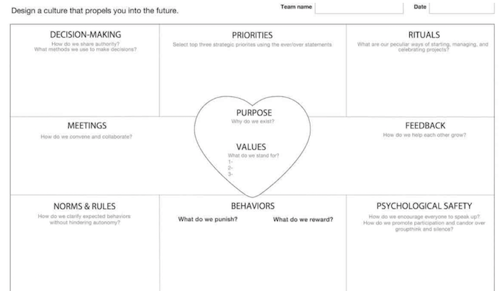Looking to scale-up your business? Wondering where to start and how to put the right structure in place? You could do worse than getting to grips with your culture. For the past 10 or so blogs, this has been my main focus. Quite simply, it’s vital. Nothing will influence your future growth more than the culture you’ve built in your company. I know this because I’ve lived it. Cultural changes made the biggest difference when I was MD of Rackspace and Peer 1. They enabled us to grow from zero to £30m within five years and through two recessions.
You may already be familiar with the theory. It all sounds great on paper. But how to put it into practice? That’s more tricky. As a business growth coach, I’m constantly on the look-out for new tools and techniques to give my clients clarity. For a while, I’ve been searching for something that brings all the elements of culture together into a framework for execution. That search ended when I came across the Culture Design Canvas.
What is the Culture Design Canvas?

I first came across Gustavo Razzetti’s work on Medium. What a great platform. If you don’t subscribe to it, start now! It’s useful for suggesting long-form content from thought leaders in your sector. Razzetti’s blogs resonated with me. In fact, he impressed me so much that I invited him onto my Melting Pot podcast. Here, he talks about his new tool, ‘The Culture Design Canvas’. And since then, I’ve taken his accreditation programme to really understand how to use this tool in client businesses.
Gustavo spent twenty years helping teams work smarter and partnering with clients to design fearless workplace cultures. Now he’s distilled his knowledge into this easy to implement tool. Crucially, it makes culture actionable. Whether you’re designing a new workplace or mapping an existing one, it works equally well. The simple, visual chart will help you understand your current state and define the future by working through a number of key areas.
The Culture Canvas has been used successfully by companies the world over. Spotify, Airbnb, Pixar, NetFlix – the list goes on. Its beauty is its simplicity. Working through the different columns will bring your culture to life in a palatable, digestible format that’s easy to communicate to your staff. It can then be used to guide recruitment, on-boarding, staff engagement, management training etc.
Start with ‘Purpose, Values and Behaviours’

When we begin, I ask clients to re-visit the foundational elements of purpose, values and BHAG. These sit at the centre of the chart as they are the beating heart of your culture. Hopefully, you’ll already have a good idea of what these elements are before you start. It works better that way. They need to be original and unique to your business. Don’t fall for generic words like ‘integrity’, ‘teamwork’ and ‘quality’. Make them specific.
Your values act as pointers towards the behaviours that are important to you. We work through what these are, getting really clear on the ones you’re going to reward and also punish. Look at this from both sides. Get deliberate about creating reward programmes that really mean something. Think about less desirable behaviours – maybe by remembering people who have exited the business. What was it about their behaviour that meant they weren’t a great cultural fit?
Often, clients highlight a lack of personal responsibility and accountability – this is pretty common. Particularly in bigger companies. It often shows up in general housekeeping – leaving cups in the sink, assuming that it’s someone else’s job to clear up etc. Out of this, some of my clients have identified positive behaviours like ‘See it, fix it’.
Move on to ‘Priorities’
Also in the centre are the top three strategic priorities that act as general guides in your business. I like the way these are written using ‘even over’ statements – it gets really clear what’s most important. So Ikea’s priorities would be ‘Durability even over style’ or Zappos, ‘Wow our customers even over sales profit’. By agreeing on this together, decisions should get easier. Now, everyone knows the three big things that this business values, one over another.
One of my clients, New Signature UK, came up with ‘Casual success over heroic endeavour’. For them, everything is about scalability. They’ve grown from £8 million to £30 million turnover in the time I’ve been working with them – pretty stratospheric growth. From the outside, they want it to look as though their success has been casual. They know it’s been anything but. Someone going the extra mile is not scaleable for them so isn’t a priority. More important is ‘Teamwork over individual excellence’ and ‘Long term shared success over short term gains’.
Another client, Clearvision, took a different tack. Their priorities included, ‘A Players over everyone else’ and ‘Contribution over comfort zone’. They wanted to make it clear that working for them is not about sticking to a job description. They’re looking for people to make contributions at both a cultural and commercial level. And they want to hire ‘Learners’ who like being outside their comfort zone.
Work out your rituals
Ah yes – rituals. Do you have any? Have you analysed their value? The culture canvas helps you understand what these are and why they’re important. I often refer to the work of Edgar Schein at this point. In his book, ‘Organisational Culture and Leadership’, Schein compared culture to an iceberg. Above the water were the tangible elements such as the stories, structures, documented processes and artefacts. Below the water was a much bigger mass of invisible assumptions, unconscious beliefs and ways of thinking. These are the things you need to uncover and understand.
As part of the process, the Culture Canvas takes you through how to define a ritual. Many clients have them already but haven’t been clear about what they’re for and why they exist. Clearvision believes in ‘Lessons learned from failure’ and so their ritual is a post-mortem after every big project. They don’t punish failure but reward learning.
Decide how you give feedback and create psychological safety
Two other important aspects of a healthy culture – feedback and psychological safety. Ongoing, two-way communication is vital to improving teamwork and building self-awareness. They often say feedback is a gift – the more you practice it, the better you get at both giving and receiving it. This is your opportunity to get to grips with how you do this to help each other learn and grow. It might be through a ‘Stop, Start, Continue’ approach or weekly 1:1s and staff surveys – anything that’s unique to your company. You’re aiming for a culture of radical candour and coaching.
Hand in hand with feedback is psychological safety. This comes up all the time when I’m coaching clients. Making sure the CEO knows not to speak first is a good start. Because if they do, everyone else will cluster around them. Getting everyone used to writing their opinions down first and then sharing so you get divergent views. Committing to ways of relating to each other and making sure they’re understood by everyone. I was speaking to a client recently who has some difficult strategic decisions to overcome and suggested using a pre-mortem to prepare the ground. It’s so important to get people’s input before the CEO speaks.
Finish with decision-making, meetings and rules

The last column deals with the three remaining pillars of a successful culture, the first being decision-making. Will this be democratic or autocratic? How will authority be distributed? When I worked through this with Clearvision, they settled on ‘Data first, emotion second’ and ‘A decision over no decision’. It was all about pace, momentum and speed for them. They emphasised how their values should guide their decisions. New Signature opted for ‘Swift, transparent and defendable’. In their company, you won’t get into trouble for doing the right thing for the right reasons. There’s an impetus to decision-making – they don’t want a lack of decisiveness to slow you down.
Meetings – so important. I’ve said many times that meetings hold a mirror to a company’s culture. Do they begin and end on time? Are people treated with respect? Is everyone paying attention? Through the Culture Canvas, you can formalise and commit to better meetings. Something that’s particularly relevant at the moment is the impact of remote working on meetings. My view is organisations should commit to ‘one remote, all remote’. I’ve been to sessions recently that were half and half and interactions were really difficult.
The final box is ‘Rules and Norms’, a good place to put anything that hasn’t been covered elsewhere. Maybe you could highlight the importance of good housekeeping or rejecting gossip. When it comes to rules, get rid of the ones that are annoying or frustrating to your staff. Keep rules to a minimum and focus on enabling your people rather than limiting them.
Implementing the Culture Design Canvas
Completing your Canvas is momentous. You’ve agreed, as a team, how you want your business to be. How you’re going to behave and work together. How you will treat each other. You’ve analysed every part of your culture together and now have a holistic framework that you can roll out to the rest of your business. Magic!
Take this out to the rest of your teams. Culture starts at a team level, so suggest that each manager runs through it and relates it to their particular dynamic. Give them the opportunity to feedback to you. Perhaps there’s a ritual that you missed. Or one of the highlighted behaviours doesn’t happen consistently.
Feedback from my clients has been overwhelmingly positive. They like how easy it is to communicate. It’s a simple visual that can be put on the wall and referred to every day, whether in recruitment, management training, onboarding or staff development. Conversations around what to change become more straight-forward. If something’s wrong in a particular team, you now have the evidence to do something about it. Perhaps a manager’s 1:1s aren’t strong enough or they’re not being sufficiently candid. Conversely, you can see immediately when people are living and breathing the culture that you’ve defined and can use the Canvas for promotions and rewards.
It’s so valuable to have a true measure of cultural fit. This will ensure you attract and retain the right people. Managers will know your expectations around creating psychological safety as well as how they should run meetings. And everyone will be accountable, from top to bottom, for making decisions in the way you’ve decided.
Somebody asked me recently how I stay fresh and don’t get bored with coaching. After all, I’m using the same tools day in, day out. I told them that every client is different. They all have unique problems. And that’s what keeps me interested. Depending on their challenge, I dive deeper into certain tools. Or I find new ones like the Culture Design Canvas. Learning new approaches and expanding my knowledge has always been what makes me tick. Along with the satisfaction of seeing my clients’ businesses grow.
Written by business coach and leadership coaching expert Dominic Monkhouse. Contact him to schedule a call here. You can order your free copy of his book, Mind Your F**king Business here.

